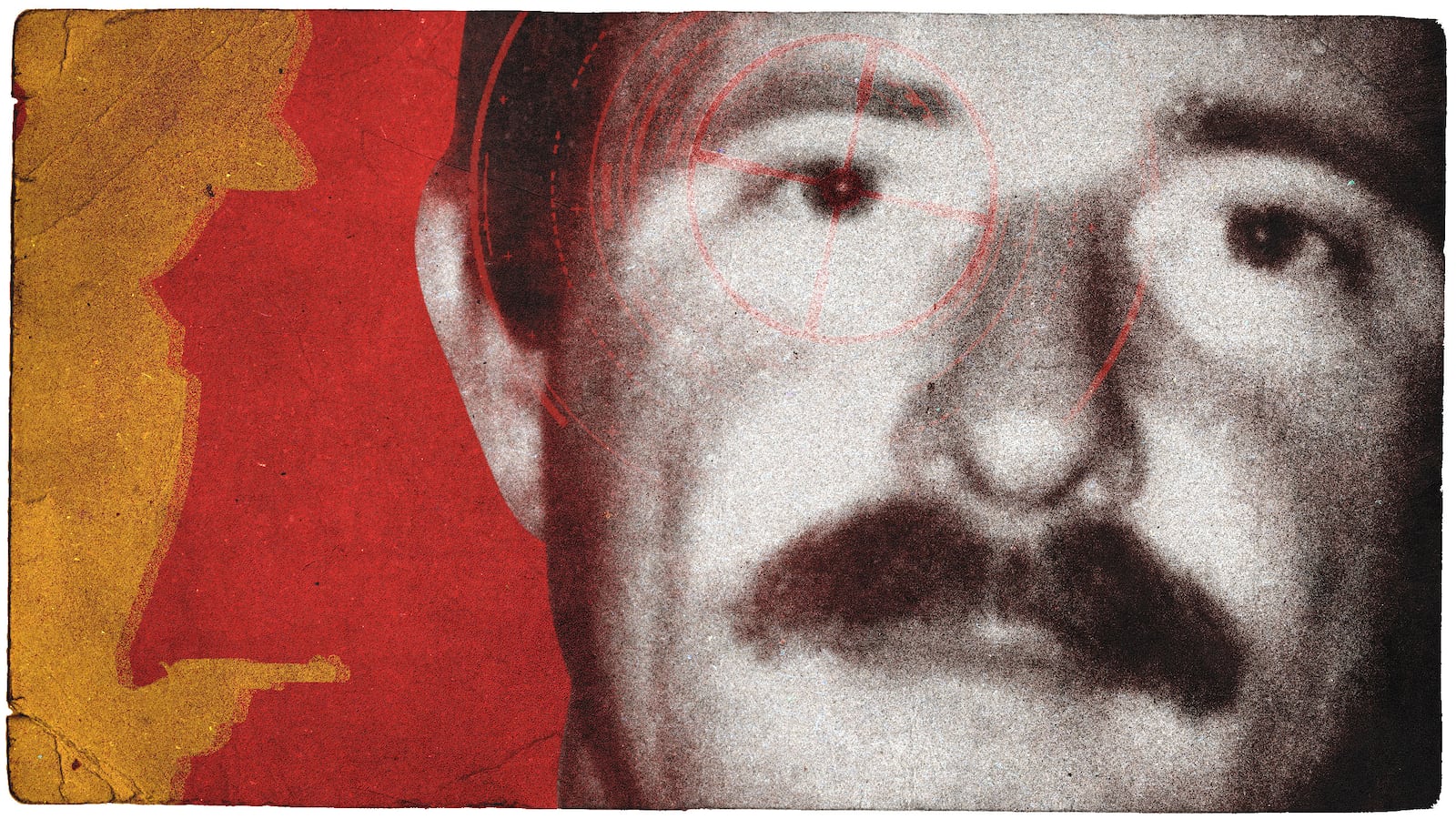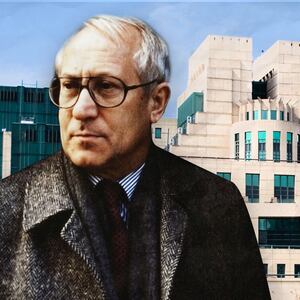TBILISI, Georgia — On August 8, 1993, the acting CIA station chief in the Republic of Georgia, Freddie Woodruff, was shot in the head as he traveled along the Georgian Military Highway, an ancient Russian imperial road that snakes out of the Georgian capital of Tbilisi through the Caucasus mountains.
Woodruff had volunteered for temporary duty in Georgia in those heady days just after the 1991 collapse of the Soviet Union — the end of what had seemed the endless Cold War. He might have been a “good ol’ boy” from Weatherford, Oklahoma, as former CIA Director John Brennan once described him, but he spoke fluent German, Turkish, Greek and Russian and, in Brennan’s words, was “a consummate intelligence officer.”
On that Sunday in August 1993, Woodruff was taking a day trip into the dramatically beautiful Georgian countryside with Eldar Gogoladze, a former colonel in the recently defunct Soviet KGB who had been made head of the security team for Eduard Shevardnadze, the former Soviet foreign minister who had become Georgia’s leader. Part of the CIA brief was to help train those protecting Shevardnadze, and Freddie and Eldar became not only colleagues, but friends.
“Freddie was deputy head of the Caucasus and Central Asian division,” Eldar recalls. “He was the acting station chief. He loved Georgia. He was like us, you know. He could have sent someone else here, but whatever opportunity he had, he was coming.”
Like the Georgian landscape with its stunning mountains, ancient castles and even more ancient mysteries, the various accounts of Woodruff’s death are full of byzantine complications.
Some explanations center on Woodruff’s investigation of the Georgian mafia’s bustling trans-Caucasus heroin trade. Others see the hand of the CIA double agent Aldrich Ames, a Russian mole at the heart of the agency who visited Tbilisi a week before Woodruff was killed and came under very heavy FBI surveillance in the United States a month after. He was arrested by the FBI the following February.
If things weren’t murky enough, riding in the car with Freddie (the American CIA operative) and Eldar (the former KGB spy) were two women friends, Elena Darchiashvili, a housewife a little out of her depth in this company, and Marina Kapanadze, Freddie’s lover, who fit right in.
Marina Kapanadze, it should be noted, was known in some circles as “Black Marina” because of her relatively dark complexion, her shady intelligence connections, and her even shadier mafia ties.
Despite all of the potential intrigue in that little Russian Lada SUV driving out of Tbilisi, the crime immediately was pinned on a drunk 20-year-old villager named Anzor Sharmaidze who was very likely tortured into confessing. He spent the next 15 years in prison for supposedly firing a random shot at the passing car that killed Woodruff. According to Georgian justice, it was just bad luck that a senior CIA officer's head got in the way.
Few believed this to be true. But Georgia was in the midst of a civil war, and Russia, its big brother to the north, wasn’t much better off. The infamous Jaba Ioseliani and his paramilitary group the "Mkhedrioni" had grown used to ruling Georgia by force. Shevardnadze had just recently been elected Chairman of Parliament and Head of State. He urgently needed U.S. support and Washington wanted to give it.
The murder of a top American intelligence officer was not going to help Georgia’s case. So the United States didn’t ask questions, or at least publicly it didn’t.
Maybe the truth has simply been lost, along with the bullet that killed Freddie Woodruff has simply been lost. (His brain, too, went missing.) But as of now, all signs point north to Russia, where at least one of the intelligence services badly disrupted by the upheaval of the previous few years wanted to send a message: “No spy games in our back yard or else.”
Various investigations into Woodruff’s killing have focused on those who were in the car that day, as they are the only ones certain to know what happened. Yet as an FBI team discovered, one of the women, poor Elena, was scared into silence. Another, Marina Kapanadze — the supposed femme fatale of the story — has remained in the shadows, leaving her connections a quarter century ago unexplained.
As one Georgian source told The Daily Beast, “her first husband was a low level GRU soldier, then a warrant officer.” The GRU was the Soviet and then the Russian military intelligence agency, which recently has attained a stunning reputation for ineptitude. But that does not seem to have hurt Marina’s ex, according to this source. “He is now on the security team of the Russian disinformation operative Igor Giorgadze.”
That’s a particularly interesting connection. Igor Giorgadze is a former Georgian intelligence chief who is currently exiled in Russia after accusations he tried to kill Shevardnadze at least once in the 1990s. The slippery Igor was on a secret trip to Russia during the 1995 assassination attempt and was later charged with plotting the failed murder. “Black Marina” by some accounts became a Russian arms dealer.
We know much of this thanks to a new book, The Spy Who Was Left Behind: Russia, the United States, and the True Story of the Betrayal and Assassination of a CIA Agent, by Michael Pullara, an American attorney who has spent the last quarter century trying to figure out the death of Freddie Woodruff.
Igor Giorgadze, for his part, has spent most of that time more or less hiding out in Russia while attempting to stay relevant in security circles. In the book at one point in this long investigation he told Pullara’s researcher:
“I can prove that I did not try to kill Shevardnadze… I was trained in Department Thirteen of the First Chief Directorate of the KGB — executive actions, assassinations, wet works. I am an expert in these things. The Georgians say I tried to kill Shevardnadze. But Shevardnadze is not dead. As a result, the only reasonable inference is that I did not try to kill him. Because if I had tried, he would be dead.”
Shevardnadze died of natural causes at the age of 86 in 2014.
Amid all of these spy games it’s easy to forget that the drunk villager Anzor Sharmaidze who also was in the wrong place at the wrong time, and apparently with the wrong weapon, spent nearly 15 years in prison for a crime he very likely did not commit.
Pullara, an attorney who took on Sharmaidze’s case pro bono deserves credit for getting him released. Thanks are due as well to journalist Andrew Higgins, who put the story on the front page of the Wall Street Journal in 2008.
Yet the Georgian authorities have not provided anyone to replace Anzor as the prime suspect. And that adds an extra element of tragedy to the death of Freddie Woodruff. As is too often the case, global politics and spy games took precedence over justice. (In recent weeks the Khashoggi case has been a reminder of that.)
As one digs more deeply into what happened to Woodruff, it is worth remembering that while CIA operatives and other spies proudly say they “tell truth to power,” that doesn’t mean people in their profession tell the truth to anyone else.
As a journalist or investigator, how do you trust spooks who lie — who disinform — for a living? This was a question Michael Pullara struggled to answer from the beginning of his inquiries and in the end his book raises more questions than it answers. But Pullara does bring to life what was a very dark time for Georgia.
Pullara spends a lot of the book attempting to pin the murder on the man driving the car that Sunday: Eldar Gogoladze, the former KGB colonel who’d become Freddie’s good friend.
Indeed, Eldar told The Daily Beast in an exclusive interview here in Tbilisi that he and Freddie were best friends.
Pullara characterizes Eldar as an “insecure bully” who betrays his CIA buddy and who was working as a triple agent on behalf of the GRU at a time when the old Soviet KGB was being reorganized and there was a lot of jockeying for power among the newly Russianized intelligence services.
“The author is an idiot,” Eldar said. “At the minimum he is obsessed and trying to get back the money he put in over 20 years.”
Pullara writes in his conclusion that Eldar Gogoladze and Marina Kapanadze “were GRU operatives, and they both would have had to know from the beginning that the true purpose of the excursion was to murder Freddie. They did their jobs and they were handsomely rewarded for their participation in the conspiracy,”
Eldar laughed at the notion he was a triple agent. Pullara, he said with a grin, “doesn’t even know that KGB cannot be infiltrated by the GRU. It’s vice versa. Only the KGB was legally allowed to infiltrate GRU.”
Or so says the KGB man.
It is apparent that Michael Pullara went to a great deal of trouble to insert himself into his client’s story, and he ultimately did succeed in freeing the man as he set out to do, although in Georgia as elsewhere freeing a person and proving they really are innocent are two very different things.
Pullara’s book seeks to make a case for innocence by running down every lead, but many are dead ends.
He writes that he hired “two agents from a European intelligence service” to track down Marina Kapanadze, for instance, but to no avail.
Pullara is at his best when he follows the evidence as an investigator and then lays it out like a litigator, but he favors cooperative witnesses, and imputes dire motives to those who didn’t play ball.
Eldar Gogoladze was not helpful to Pullara. The two men do not get along, and Eldar was not the only Georgian who wondered why Pullara, from Texas, was so fixated on this faraway miscarriage of justice.
Not long after slippery Igor Giorgadze, the intel chief accused of attempting to assassinate Shevardnadze with a car bomb, fled to Russia in 1995, his successor in the Georgian security services, Shota Kviraya, made a very public accusation. Kviraya accused Igor Giorgadze of orchestrating the murder of Freddie Woodruff – but he claimed that Eldar was in on the hit as well.
Silver-haired Eldar Gogoladze is physically rugged and mentally sharp at 70 years old. When asked directly if Russia was behind the murder of his friend Freddie, his response is enigmatic and more than a little convoluted. “Hypothetically it’s possible that it was Russia but if Sharmaidze [the drunk villager] was [a Russian] assassin he would have emptied the whole magazine of his weapon…”
But what if the kid did not shoot Freddie Woodruff to begin with?
“Such things are always followed by conspiracy theories. If the Russians wanted to kill him, they could have.”
Eldar's point is that Freddie Woodruff was an easy target. Conspiracy theorists love to spin out elaborate plots, but real assassins prefer simplicity. Freddie was around Tbilisi, and there would have been plenty of chances to kill him. There were also plenty of opportunities when Eldar himself could have done so without witnesses, had that been his intent.
As Eldar points out and as Pullara confirms in his book, Freddie Woodruff had a very serious heart condition – one he likely played down to Langley. According to Eldar, Freddie came to him for help regarding that heart condition and Eldar took him to Shevardnadze’s personal physician who said that Freddie should be hospitalized immediately.
All of that made the acting CIA station chief incredibly vulnerable.
“If I was GRU, why should I have done it in that car? The shot was from behind. Do I look like an idiot? I don’t believe that this was a Russian operation.”
What about the theory that the mole Aldrich “Rick” Ames may have fingered Freddie Woodruff to the Russians? “Rick was removed from any real secrets by then,” Eldar says, and he was in no position to go ordering hits.
“The first time I met Rick was here in Tbilisi. He was drinking a highball. I remember him always having a glass of alcohol in his hand. Probably how he was killing stress. Probably traitors have to drink alcohol.”
But Pullara’s conclusion, and one shared by several specialists, is that precisely because Ames was on the verge of getting caught, he orchestrated the murder of Freddie Woodruff to protect his cover.
By August 1993, Ames had spent nearly a decade handing classified information over to the Soviets and then the Russians. It was one of the largest breaches in the agency’s history. Ames made $4.5 million and betrayed the names of hundreds of foreign agents, many of whom were imprisoned or executed.
As the theory goes, on his visit to Tbilisi a week before Freddie’s death, Ames got drunk (as he was prone to do) and revealed himself to Woodruff, who then became another one of his victims. But Eldar doubts that the Russians would have killed Freddie to protect a mole who by 1993 was already under investigation and had little value.
Eldar acknowledges that “Black Marina” Kapanadze “could have been a Russian source, theoretically, but there is no way she could have pulled the trigger.” After all Eldar would have noticed the shot. He was driving the two-door SUV and “Black Marina” was in the back seat with Freddie.
As for questions that Pullara brings up regarding the direction of the bullet, the bullet holes on the vehicle, the blood and the ballistics, Eldar is dismissive: “The FBI and CIA never had these question marks. The bullet left a trace just above my head. The best people from the FBI and the CIA even identified the height of the shooter. The lawyer [Pullara] blames the FBI and CIA, that they betrayed Freddie somehow. But Freddie already had a new job in Prague at the time.” He wasn't ready for the grave.
The septuagenarian spy continues, “We were so close friends, even discussing what we should do for our retirement. The first few months I couldn’t sleep. Many times I wished that bullet hit me instead. I was his friend and I couldn’t protect him. We, myself and two other officers, were Freddie’s hosts. If that bullet had hit me, no one would be making a big deal out of my death.”
As for whether inebriated Anzor Sharmaidze shot Freddie Woodruff, Eldar Gogoladze says, “It was the shot of a drunk man… I do not have doubts.”
“It’s such an unprofessional theory that Rick Ames told his handlers to kill Freddie, it’s like something from a low-level movie.”
To all intents and purposes the murder remains unsolved. But there are some very tantalizing clues left almost on the fringes of the case.
Let’s take Pullara’s account of an interview with Kote Shavishvili, a retired general from the elite KGB special forces Group Alpha, which performed paramilitary and covert operations domestically and abroad.
In the book, Kote tells Pullara, “In 1993, I was second in command of Georgian Group Alpha under Igor Giorgadze—and it was my job to organize such things and to provide trained operators for support.”
By “such things,” Kote is referring to political assassinations. And yes, that is the same Igor Giorgadze accused of trying to blow up Georgia's president.
According to Kote, “Black Marina” was part of the Group Alpha operation as well, and was rewarded later. “She got a job in the West—working for the Russians. The Ministry of Defense, I think,” Kote says.
And was there a professional hit man? “He was no professional!” Kote yelled at Pullara.
The FBI’s investigation into the Woodruff killing led them to a Russian mercenary with a war-mangled hand. His name was Vladimir Rakhman. The Georgian police detained him at a train station days after the murder. Rakhman was carrying a silencer and two gas canisters. (“One professional does not steal another professional’s tools!” Kote shouted at Pullara, perhaps in reference to the assassin’s gear in Rakhman’s possession.)
The FBI did not know what to make of Rakhman. Today his whereabouts are unknown.
And then there’s this: Andrew Higgins wrote in his 2008 Wall Street Journal article about the Woodruff case, “The CIA had picked up reports that a man with a mangled hand had popped up elsewhere in the Caucasus and was trying to drum up business for a murder syndicate known as Mongoose, according to people familiar with the affair. Part of his sales pitch: the syndicate had murdered Mr. Woodruff.”
Mangled hands and shadow assassins — just when you think you’ve begun to make sense of the evidence … enter the Mongoose.
Even 25 years after the murder, after many lives have been ruined and after reading Pullara’s 350 pages, the same questions remain. Who killed Freddie Woodruff and why? Of the three others who were in the car that day, Elena Darchiashvili hasn’t been seen in years and “Black Marina” is supposedly working in Athens, but it seems she cannot be reached.
Only Eldar Gogoladze remains in Georgia, and his story hasn’t changed.












